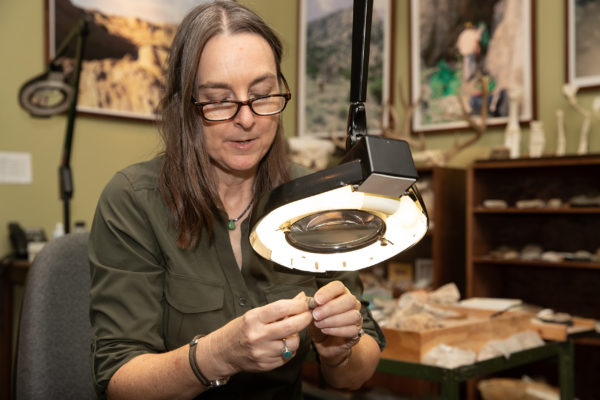Just east of San Jacinto Boulevard on The University of Texas at Austin campus, dual grand stairways flank a steep lawn topped with what seems to be a monolith. Five boys from Lakeway Elementary School laugh as they jump between bone-shaped seats modeled after a mosasaur’s vertebrae.
Through the grand doors of the Texas Memorial Museum — which bills itself as Austin’s first science museum — a small team of staff members and volunteers was leading activities and identifying specimens as part of National Fossil Day.
“Not only does paleontology inform us about life in the past, it can inform us about life today. … It gives us this beautiful continuum of time,” says Pamela R. Owen, the museum’s associate director.
National Fossil Day, which takes place annually in October, was started by the National Parks Service and partner institutions nationwide in 2010. But the university’s natural history museum has long opened its doors to amateur fossil collectors who want to know more about their finds. The museum held its first Identification Day in January 2000, founded by Dianne Folkerth, the education coordinator from 1999 to 2005.
“I found an old photo of myself from 2000 sitting at one of the tables, so I’ve been doing fossil IDs for the public for quite some time,” Owen says.
Owen moved from California to attend UT Austin in the fall of 1992. She graduated with a doctoral degree in geological sciences, with an emphasis in vertebrate paleontology, in the spring of 2000, then worked as collections manager for the Vertebrate Paleontology Laboratory until 2003. She was senior paleontology/biodiversity educator at the museum from 2003 to 2014 before becoming associate director.
As a student, Owen spent more of her time at the J.J. Pickle Research Campus, which still houses most of the university’s paleontological and geological collections. But even then, Owen says she took the time to engage with outreach opportunities at the museum. She volunteered for the first Identification Day and helped with organizing collections.
“Fossils are all over Central Texas,” Owen says. “People that walk along creek sides or road cuts will find them. I laugh because the kids here can walk any creek, like Shoal Creek, and they just scoop up fossils. We didn’t have that in California.”
During the most recent National Fossil Day, Owen took off her administrative hat and prepared to educate visiting schoolchildren and other members of the public about the work of a paleontologist. She attached a camera to her binocular scope so that visitors could get a better look at what she was examining with a small set of tweezers.
“This is a sample bag from a site called Cathedral Cave out in Nevada. We’re looking at the last ice age,” Owen says. “A lot of the primary research is done, but there’s still plenty of these bags of cave matrix to go through, so we can do what we call picking.”
Ben Grall, the museum’s visitor services manager, sold tickets and gave guests a quick rundown of what they would find on each floor. Michael R. Fallon, the museum security guard, was on duty, and Laura Naski Keffer, senior administrative associate, continued to work behind the scenes.
Owen also has trained 31 volunteers over the years.
John Tate, a volunteer for two years, manned a table on the museum’s first floor as families circled about and Lakeway Elementary students fired off questions about the dinosaur and armadillo exhibits that towered above them.
Tate is a UT alumnus and a former state employee who says that after he retired, he wanted to reconnect to subjects he was passionate about in college. Tate earned a degree in philosophy; during that time, he took classes in the philosophy of science and developed an interest in evolutionary theory.
“I don’t really know the details of paleontology except what I’ve learned since I’ve come here, but I understand evolution,” Tate says.
On the table in front of him rested what looked like a piece of petrified wood, or a smoothed, brownish-amber rock with divots across the top. Tate pointed to different parts of the fossil while wide-eyed Wyatt Stutsman, 7, of Manor listened, eager to chime in.
“The mammoth’s tooth is kind of flat, and it’s really tall because the mammoth ate grass. And grass has silica in it. And so if you eat grass all the time, it wears down their teeth,” Tate says.
Wyatt jumped in to tell Tate he has one at home that is “this” wide — he held his hands about a foot apart. He told Tate it was from a newborn mammoth.
“I still have it. My grandpa gave it to me,” Wyatt says.
In addition to National Fossil Day and Identification Day, the museum team and volunteers offer community events such as Texas Wildlife Day, Pop-up Naturalists Art Studio, story times and other hands-on activities for children. Off campus, the museum has collaborated with the Austin Nature & Science Center and with Zilker Botanical Garden’s Hartman Prehistoric Garden.
“I like bones,” laughs Owen. “Some days I think, wow, look at these millions of years of history, look at all this diversity, and other days I will be walking around in here thinking we’ve got decades of work that we are making available to the public. It’s a sense of pride. I have the opportunity, and I’m blessed to be a caretaker of these wonderful treasures.”
I laugh because the kids here can walk any creek, like Shoal Creek, and they just scoop up fossils. We didn’t have that in California.



